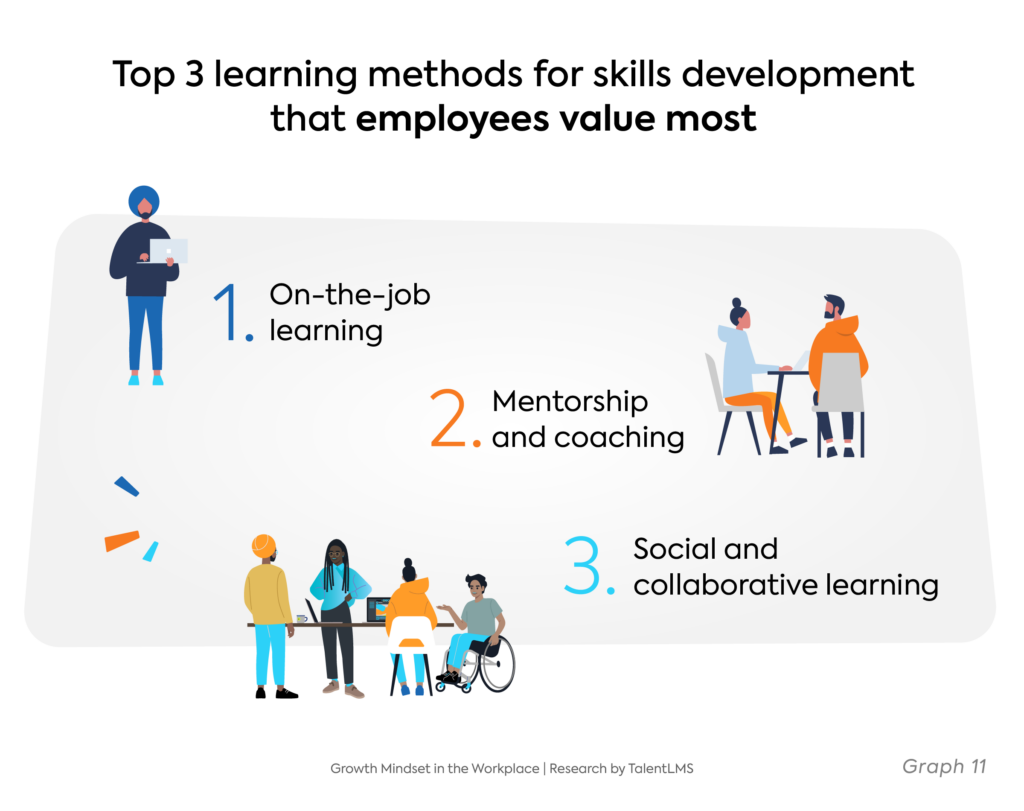- 20+ Helpful Recruitment Advertising Agencies (2026) - January 5, 2026
- 16 Helpful Career Site Self-Service Tools for You - December 18, 2025
- Last Week I Had a Viral LinkedIn Post — But Why? (And What TA Folks Can Learn From It) - December 8, 2025
What is “growth mindset language”? And, how do you use it to create better job ads? A growth mindset means showing there’s room to learn and improve, in a positive way.
When someone has a growth mindset, they believe they’re not limited by inherent abilities. They’re able to grow, change, and also adapt. This theory is used a lot in education but also applies to business. Encouraging a “growth mindset” in your biz boosts morale and trust between colleagues…and increases innovation.
Workplaces that value a growth mindset focus on:
- Effort and consistency over talent
- Training and growth opportunities
- Coaching through management and peers
- Being open to innovation and risk-taking
- Seeing mistakes as learning opportunities
- Being open to feedback and discussion
- Constructive feedback aimed at learning and improving
So how do you build this into your job ads?
3 Ways to use “Growth Mindset” Language
The words you use in your job ads show candidates what you value. Here are 3 ways you can use growth mindset language to make a positive impact:
- List coaching, training, or continuing education opportunities in your “Benefits” section. Job seekers who value constant learning will see this as a big perk.
- Mention “collaboration culture” in your “About Us” or “Diversity Statement” section. Showing you value collaboration, especially between different types of employees, shows candidates you have a “growth mindset.”
- Talk about “innovation” or “problem-solving” in your “Our Mission” section. Candidates care about making the world a better place, especially through growth-focused initiatives at work.
3 Examples of “Growth Mindset” Language
If you like examples from other co.s, here are 3 from McGraw Hill, Calm, and IBM (for more inspiration):
McGraw Hill
McGraw Hill uses growth mindset language like “curiosity” and “drive learning forward” as a part of their passion in this Product Manager job ad:

Calm
Calm shows they value a growth mindset with words like “can-do attitude,” “collaboration,” and communication in this job ad:

IBM
IBM’s job ad for a Partner Technical Specialist uses growth mindset language based on “a culture of continuous learning”:

The Business Case for Growth Mindset in Job Ads

Highlighting the importance of a growth mindset in job ads is more than a buzzword. It’s also a driver of profitability. According to TalentLMS, 80% of executives agree that employees’ mindset directly contributes to revenue growth. Therefore, organizations that embed growth-based mindset principles in their recruitment processes are more likely to attract candidates who are adaptable, innovative, and ready to thrive in a dynamic work environment.
The Role of Leadership in Fostering Growth Mindset
The future of business success hinges on leadership that embraces this mindset, with 89% of senior leaders agreeing that leaders must embody this approach to secure future wins. When writing job ads, emphasize leadership opportunities that focus on continuous learning and development. Thus, promoting a culture where curiosity, resilience, and adaptability are celebrated.
Addressing the AI Impact on Growth Mindset

Job ads should also consider the influence of technology on learning. With 53% of executives believing that generative AI may hinder the development of a growth mindset, companies must convey that they value human-centered skills. So, highlight that roles require active listening, critical thinking, and time management to balance technology’s rapid advancement and maintain a workplace focused on growth.
Growth Mindset and Employee Retention

In today’s competitive job market, learning opportunities are key to retaining talent. More than half of employees (52%) say they would leave their current job for a company that offers more learning and development opportunities. Therefore, by weaving language that emphasizes continuous growth into job ads, companies can attract candidates who are invested in their long-term career development, leading to better retention rates.
Overcoming Barriers to Growth
To create a culture of growth, job ads should address potential roadblocks that employees might face. Fear of failure, resistance to feedback, and discomfort with change are common obstacles in the workplace. So, emphasize that your company values learning from mistakes and welcomes new ideas, showcasing a workplace culture that supports employees in their growth journey.
Leadership By Example: The Key to Growth

Research further shows that 90% of executives believe leaders must lead by example to foster a growth culture. So, when drafting job ads, mention leadership qualities that involve collaboration, coaching, and learning from challenges. This can also inspire future candidates to see themselves as part of a forward-thinking, growth-driven team.
Closing the Growth Mindset Gap

Although 96% of executives claim to embody this mindset of growth, only 45% of employees feel their leaders demonstrate it in practice. Therefore, when writing job ads, focus on clear, actionable commitments to growth and leadership development. This can also help bridge the perception gap and create a more aligned culture where both leaders and employees work towards mutual development.
Prioritizing Continuous Learning in Job Ads

Furthermore, 87% of executives emphasize offering continuous learning opportunities as vital for a growth culture. So, take the time to be specific about the programs and initiatives your company offers to support learning, whether it’s formal training, mentorship, or the encouragement of experimentation. This will resonate with candidates eager to grow in their roles.
Why I wrote this?
Ongig’s mission is to create effective and inclusive job descriptions. Our software allows you to create consistent templates to highlight growth mindset language in your JDs. So, please request a demo to learn more.
Shout-outs:
- How and Why to Develop a Growth Mindset in the Workplace by Rachel Hastings
- How To Promote a Growth Mindset in the Workplace by Vinita Bansal
